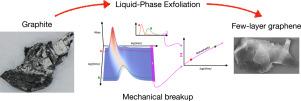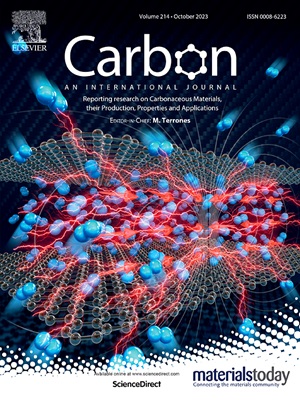利用种群平衡建模预测石墨烯产量
IF 10.5
2区 材料科学
Q1 CHEMISTRY, PHYSICAL
引用次数: 0
摘要
为了实现石墨烯及相关二维材料的可持续生产和工业应用,一个有待解决的重要因素是在特定操作条件下预测材料生产的能力。在本研究中,通过监测石墨颗粒在自上而下的液相剥离过程中发生破裂时的分布变化,我们发现统计种群平衡模型(PBM)是确定石墨烯纳米片以及石墨烯纳米小板等其他相关数量的产量和未来生产的可行且有效的解决方案。激光衍射和少层石墨烯浓度测量相结合,分别用于恢复材料分布和拟合所有尺度的 PBM。拟合后的 PBM 可用于检查随时间变化的生产情况,或与核磁共振质子弛豫测量相结合,恢复表面积与颗粒尺寸的比例关系。此外,为了检查容器内的动态工艺条件,在合成过程中,放射性标记的石墨片和密度匹配的玻璃珠可作为正电子发射粒子跟踪的示踪粒子。这种拉格朗日粒子跟踪技术可以在时间上重建示踪粒子的位置,从而对剥离系统内部的平均量进行遍历测量。总之,这些结果和模型为二维材料的剥离过程所依赖的断裂机制和流体动力学提供了见解,并为强化和优化合成过程提供了方向。本文章由计算机程序翻译,如有差异,请以英文原文为准。

Predicting graphene production with population balance modelling
For sustainable production and industrial adoption of graphene and related two-dimensional materials, an important factor that has yet to be addressed is the ability to forecast material production under specific operating conditions. In this study, by monitoring changes in the distribution of graphite particles as they undergo breakup in a top-down liquid-phase exfoliation process, we show that statistical population balance models (PBM) are a feasible and effective solution for establishing yield and future production of graphene nanosheets, as well as other quantities of interest such as graphene nanoplatelets. A combination of laser diffraction and few-layer graphene concentration measurements are used to recover the material distribution and fit the PBM over all scales respectively. This fitted PBM can then be used to examine production over time, or coupled with nuclear magnetic resonance proton relaxation measurements to recover surface area scaling with particle size. Furthermore, to examine the dynamic process conditions inside the vessel, radioactively labelled graphite flakes and density-matched glass beads functioned as tracer particles for positron emission particle tracking during synthesis. This Lagrangian particle tracking technique can reconstruct the position of the tracer temporally, allowing for ergodic measurements of averaged quantities inside the exfoliating system. Collectively, these results and models provide insights on the breakage mechanisms and fluid dynamics that underpin exfoliation processes for two-dimensional materials, and provide direction for the intensification and optimisation of synthesis processes.
求助全文
通过发布文献求助,成功后即可免费获取论文全文。
去求助
来源期刊

Carbon
工程技术-材料科学:综合
CiteScore
20.80
自引率
7.30%
发文量
0
审稿时长
23 days
期刊介绍:
The journal Carbon is an international multidisciplinary forum for communicating scientific advances in the field of carbon materials. It reports new findings related to the formation, structure, properties, behaviors, and technological applications of carbons. Carbons are a broad class of ordered or disordered solid phases composed primarily of elemental carbon, including but not limited to carbon black, carbon fibers and filaments, carbon nanotubes, diamond and diamond-like carbon, fullerenes, glassy carbon, graphite, graphene, graphene-oxide, porous carbons, pyrolytic carbon, and other sp2 and non-sp2 hybridized carbon systems. Carbon is the companion title to the open access journal Carbon Trends. Relevant application areas for carbon materials include biology and medicine, catalysis, electronic, optoelectronic, spintronic, high-frequency, and photonic devices, energy storage and conversion systems, environmental applications and water treatment, smart materials and systems, and structural and thermal applications.
 求助内容:
求助内容: 应助结果提醒方式:
应助结果提醒方式:


